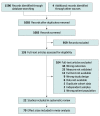Global Changes in Child and Adolescent Physical Activity During the COVID-19 Pandemic: A Systematic Review and Meta-analysis
- PMID: 35816330
- PMCID: PMC9274449
- DOI: 10.1001/jamapediatrics.2022.2313
Global Changes in Child and Adolescent Physical Activity During the COVID-19 Pandemic: A Systematic Review and Meta-analysis
Abstract
Importance: Numerous physical distancing measures were implemented to mitigate the spread of the COVID-19 virus, which could have negatively affected child and adolescent physical activity levels.
Objectives: To conduct a systematic review and meta-analysis of the literature that used validated measures to document changes in child and adolescent physical activity during the COVID-19 pandemic and to estimate whether changes in physical activity differed between participant-level, contextual, and methodological moderators.
Data sources: PubMed, PsycInfo, SPORTDiscus, Web of Science, Scopus, CINAHL, and MEDLINE were searched (from January 1, 2020, to January 1, 2022). A total of 1085 nonduplicate records were retrieved.
Study selection: Studies were included if they reported (1) changes in the duration of physical activity at any intensity for children or adolescents (age ≤18 years) comparing before and during the COVID-19 pandemic using validated physical activity measurement tools and were (2) from general population samples, (3) peer-reviewed, and (4) published in English.
Data extraction and synthesis: A total of 126 articles underwent full-text review. Data were analyzed using a random-effects meta-analysis, which was conducted in January 2022.
Main outcomes and measures: Change in the duration of engagement in physical activity at any intensity comparing before and during COVID-19.
Results: Twenty-two studies including 46 independent samples and 79 effect sizes from 14 216 participants (median age, 10.5 years; range, 3-18 years) were included. The percentage change in the duration of engagement in total daily physical activity from before to during COVID-19 was -20% (90% CI, -34% to -4%). Moderation analyses revealed that changes were larger for higher-intensity activities (-32%; 90% CI, -44% to -16%), corresponding to a 17-minute reduction in children's daily moderate-to-vigorous physical activity levels. The reduction in physical activity was also larger for samples located at higher latitudes (37%; 90% CI, -1% to 89%) and for studies with a longer duration between physical activity assessments (25%; 90% CI, -0.5% to 58%).
Conclusions and relevance: Children and adolescents have experienced measurable reductions in physical activity during the COVID-19 pandemic. Findings underscore the need to provide bolstered access to support and resources related to physical activity to ensure good health and social functioning among children and adolescents during pandemic recovery efforts.
Conflict of interest statement
Figures


Comment in
-
From COVID to Couch Potato: The Importance of Physical Activity Promotion and Education.Fam Med. 2023 Feb;55(2):72-74. doi: 10.22454/FamMed.2023.255834. Fam Med. 2023. PMID: 36787516 Free PMC article.
References
-
- Dale LP, Vanderloo L, Moore S, Faulkner G. Physical activity and depression, anxiety, and self-esteem in children and youth: an umbrella systematic review. Ment Health Phys Act. 2019;16:66-79. doi:10.1016/j.mhpa.2018.12.001 - DOI
Publication types
MeSH terms
LinkOut - more resources
Full Text Sources
Medical

